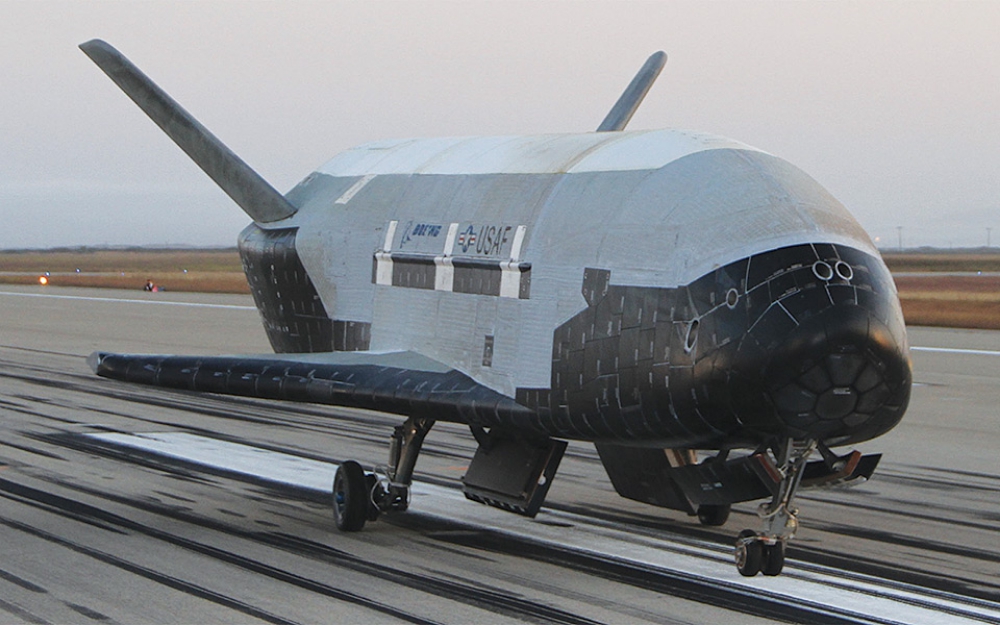The shadowy X-37B, the Air Force’s unmanned, reusable spacecraft, is set to launch for its sixth flight on May 16 from Cape Canaveral Air Force Station, Florida. While most of the payloads set for the flight are standard fare for space experiments, at least the ones that are disclosed, one of them has immense potential implications for the future of remote power generation and especially long-endurance unmanned aircraft propulsion.
The X-37B’s upcoming mission is known as both Orbital Test Vehicle-6 (OTV-6) and U.S. Space Force-7 (USSF-7). According to a Space Force press release, which went out on May 6, one payload aboard the X-37B will be an experimental system designed by the Naval Research Laboratory that is capable of capturing solar power and beaming that energy back to Earth in the form of microwaves.
While the press releases of the Department of Defense and the Space Force are scant on details, the Naval Research Laboratory’s head of beamed power has explicitly stated in the past that this system has enormous implications when it comes to long-endurance unmanned aerial vehicles (UAVs).
Beamed Power Aircraft
Using lasers to beam power to small UAVs has been a subject of research for some time. The U.S. Air Force began testing lasers as a source of propulsion for small “lightcraft” as early as the 1980s and managed to get small cone-shaped craft to fly hundreds of feet in the air propelled only by laser beams. This new concept is different, though, in that the beamed power UAVs the Navy envisions will feature traditional propulsion systems (such as rotors or propellers) and instead have rectennas that capture the energy from directed energy beams to constantly replenish their electrical power reserves.
In 2018, DARPA demonstrated its latest laser-powered aircraft, the Silent Falcon, which the project lead Joseph A. Abate says was meant to “demonstrate that remote electric refuelling of DoD systems via high energy laser power beaming to extend mission operation time in contested and remote environments.”
While lasers have been examined for their use in beaming power to UAVs, these have typically involved ground-based or possibly airborne lasers to beam power. Placing the source of power generation and transmission in space is a new take on this concept, offering superior lines of sight and a continuous, renewable source of energy via the sun.
Still, low earth orbit satellites circle the planet at incredibly high speeds and their maneuverability is limited, so there will be limitations to the Navy’s latest beamed power system, but as a proof of concept, it is essential. A constellation of satellites would likely be necessary to have a truly 24/7 supply of power, enabling UAVs to be ‘passed’ from satellite to satellite for continuous or tightly scheduled recharging. The same can be said for any receiver applications on the planet’s surface.
This technology has massive implications not only for the future of UAVs, but for all of mankind. Such a system could be used to keep UAVs in the air for very long periods of time to replace cell towers or communications satellites in the event of a crisis in a region or even for normal operations of increasingly complex communications networks. Unlike a tethered aerostat, these UAVs would require far less infrastructure, could be moved around at will for optimum coverage, and could land quickly for servicing. They could even deploy dozens of miles, or even further, away from their base stations. With a space-based power source, they could fly anywhere on earth.
So, while the X-37B’s latest mission details seem neat on a scientific level, the reality is the microwave system it is testing could change the game for many military-related applications and could actually open the door for near-continuous unmanned flight throughout the atmosphere.
Read the full version of this article in The Drive

